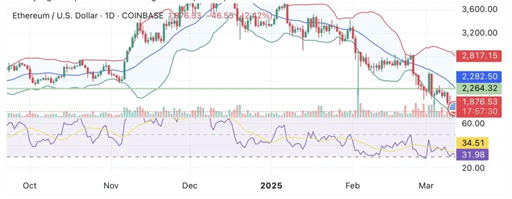REDEFINING DECENTRALIZED FINANCE WHERE INVESTMENT MEETS INNOVATION!
Ethereum Faces Pressure as it Trades Below $1,900: Challenges from DeFi and Growing Competition

Declining DeFi Liquidity and Flows
According to data from DefiLlama, the total value locked (TVL) on the Ethereum network has plummeted from $63 billion in January to $44 billion in February. This reflects a decline in liquidity and investor participation in Ethereum’s DeFi ecosystem.
Stablecoin flows into Ethereum are also slowing, indicating a significant reduction in capital turnover. This hurts Ethereum’s appeal to investors, especially when compared to rival blockchains like Solana and Hyperliquid, which are seeing increased trading volume and investment activity.
Ethereum Trading Volume and Revenue Plunge
Trading volume on decentralized exchanges (DEXs) is also declining. It hit $92 billion in December, but fell to $82 billion in February. While platforms like Solana and Hyperliquid are seeing a surge in futures trading volume, Ethereum futures trading fell from $31 billion in December to just $18 billion in February.
Ethereum’s transaction fee revenue has also plummeted. In December, Ethereum generated $193 million in revenue, but in February, it dropped to $26 million. Low transaction fees and reduced network activity are leading to declining revenue, posing a major challenge for the Ethereum ecosystem.
Ether Spot ETFs See Continuous Outflows
Another factor that shows Ethereum’s weakness is the outflows from Ether spot ETFs. According to data from SoSoValue, these ETFs have seen a total of $176 million in outflows in the past four weeks. This reflects a decline in institutional demand for Ethereum, adding to the downward pressure on the price of the digital currency.
Technical Outlook: Ethereum Facing Key Support
Currently, Ethereum is trading at $1,876, just a hair’s breadth from the key support level at $1,875. ETH’s continued support below its 50-day moving average (currently at $2,282.50) suggests a clear bearish trend.

Ethereum Technical Analysis. Credit:cryptocurrencynews
Technical indicators are also not very bullish. Bollinger Bands show increased volatility, with Ethereum hovering near the lower band, signaling oversold conditions. The Relative Strength Index (RSI) is currently at 34.51, near the oversold threshold of 30, indicating weak buying pressure but still has room to recover if demand picks up.
If ETH falls below $1,875, the price could continue to fall towards $1,800. Conversely, if there is a bullish reversal, Ethereum will face strong resistance at $2,282. ETH needs to break above the 50-day moving average to break out of the downtrend.
Opportunities from Ether ETF staking
An important development that could impact Ethereum is the inclusion of staking features in Ether ETFs. Cboe BZX has filed a proposal with the US regulator to allow Fidelity to stake its Ether ETF, following a similar proposal from 21Shares in February. If approved, investors could receive staking rewards of around 3.3%, which could spur institutional interest and provide a boost to Ethereum’s price.
Conclusion
Ethereum is facing significant pressure from both internal and external factors, including a decline in DeFi activity, reduced liquidity, and strong ETF outflows. In addition, competition from other blockchains is causing Ethereum to lose its edge. However, if staking is integrated into Ether ETFs and institutional investment demand picks up again, Ethereum could find momentum to recover in the near term.













